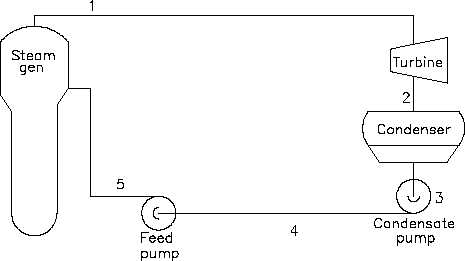FIRST LAW OF THERMODYNAMICS
Thermodynamics
Note the individual processes the fluid must go through before completing the complete cycle.
Rankine cycles will be discussed in greater detail later in this module. Figure 20 shows a typical
steam plant cycle. Heat is supplied to the steam generator (boiler) where liquid is converted to
steam or vapor. The vapor is then expanded adiabatically in the turbine to produce a work
output. Vapor leaving the turbine then enters the condenser where heat is removed and the vapor
is condensed into the liquid state. The condensation process is the heat-rejection mechanism for
the cycle. Saturated liquid is delivered to the condensate pump and then the feed pump where
its pressure is raised to the saturation pressure corresponding to the steam generator temperature,
and the high pressure liquid is delivered to the steam generator where the cycle repeats itself.
Figure 20 Typical Steam Plant Cycle
With the example complete, it seems appropriate to discuss the various components of a typical
steam plant system. Although such a system is extremely complex, only the major components
will be discussed. A typical steam plant system consists of: a heat source to produce the thermal
energy (e.g. nuclear or fossil fuel); a steam generator to change the thermal energy into steam
energy (a complete steam plant usually exists in connection with the steam generator in
converting the steam into eventual electrical energy); pumps to transfer the fluid back to the heat
source (reactor coolant pumps in a nuclear reactor); a pressurizer to ensure that the primary
system maintains its desired pressure; and the necessary piping to ensure the fluid passes through
each stage of its cyclic process. Of necessity, the steam plant is a large "closed" system.
However, each component of the system is thermodynamically analyzed as an open system as
the fluid passes through it. Of primary importance is the process of dissipating the energy
created by the heat source. This process takes place in the steam generator, which acts as a giant
two-phase heat generator.
HT-01
Page 62
Rev. 0

